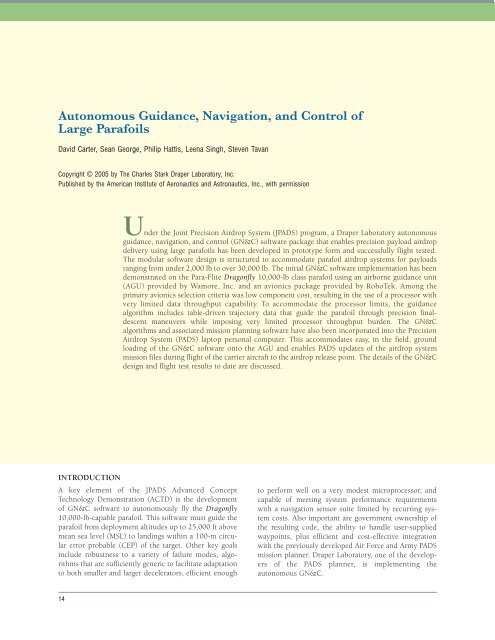TECHNOLOGY DIGEST - Draper Laboratory
TECHNOLOGY DIGEST - Draper Laboratory
TECHNOLOGY DIGEST - Draper Laboratory
Create successful ePaper yourself
Turn your PDF publications into a flip-book with our unique Google optimized e-Paper software.
Autonomous Guidance, Navigation, and Control of<br />
Large Parafoils<br />
David Carter, Sean George, Philip Hattis, Leena Singh, Steven Tavan<br />
Copyright © 2005 by The Charles Stark <strong>Draper</strong> <strong>Laboratory</strong>, Inc.<br />
Published by the American Institute of Aeronautics and Astronautics, Inc., with permission<br />
INTRODUCTION<br />
Under the Joint Precision Airdrop System (JPADS) program, a <strong>Draper</strong> <strong>Laboratory</strong> autonomous<br />
guidance, navigation, and control (GN&C) software package that enables precision payload airdrop<br />
delivery using large parafoils has been developed in prototype form and successfully flight tested.<br />
The modular software design is structured to accommodate parafoil airdrop systems for payloads<br />
ranging from under 2,000 lb to over 30,000 lb. The initial GN&C software implementation has been<br />
demonstrated on the Para-Flite Dragonfly 10,000-lb class parafoil using an airborne guidance unit<br />
(AGU) provided by Wamore, Inc. and an avionics package provided by RoboTek. Among the<br />
primary avionics selection criteria was low component cost, resulting in the use of a processor with<br />
very limited data throughput capability. To accommodate the processor limits, the guidance<br />
algorithm includes table-driven trajectory data that guide the parafoil through precision finaldescent<br />
maneuvers while imposing very limited processor throughput burden. The GN&C<br />
algorithms and associated mission planning software have also been incorporated into the Precision<br />
Airdrop System (PADS) laptop personal computer. This accommodates easy, in the field, ground<br />
loading of the GN&C software onto the AGU and enables PADS updates of the airdrop system<br />
mission files during flight of the carrier aircraft to the airdrop release point. The details of the GN&C<br />
design and flight test results to date are discussed.<br />
A key element of the JPADS Advanced Concept<br />
Technology Demonstration (ACTD) is the development<br />
of GN&C software to autonomously fly the Dragonfly<br />
10,000-lb-capable parafoil. This software must guide the<br />
parafoil from deployment altitudes up to 25,000 ft above<br />
mean sea level (MSL) to landings within a 100-m circular<br />
error probable (CEP) of the target. Other key goals<br />
include robustness to a variety of failure modes, algorithms<br />
that are sufficiently generic to facilitate adaptation<br />
to both smaller and larger decelerators, efficient enough<br />
14<br />
to perform well on a very modest microprocessor, and<br />
capable of meeting system performance requirements<br />
with a navigation sensor suite limited by recurring system<br />
costs. Also important are government ownership of<br />
the resulting code, the ability to handle user-supplied<br />
waypoints, plus efficient and cost-effective integration<br />
with the previously developed Air Force and Army PADS<br />
mission planner. <strong>Draper</strong> <strong>Laboratory</strong>, one of the developers<br />
of the PADS planner, is implementing the<br />
autonomous GN&C.

















